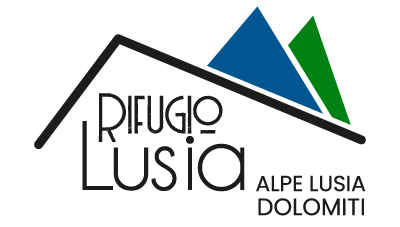History
The building of the refuge dates back to the end of the nineteenth century, by the hand of a certain Bernardi di Predazzo on behalf of Pedrotti of Trento, who then handed the running of it over to the Volcan family from Moena. The original structure of the refuge was extremely simple and it appears that the adjoining building was built even earlier to serve as a stable and hayloft.
It is interesting to learn that the refuge has always welcomed tourists from its beginnings. As a matter of fact, the first tourists either for recreational or professional purposes gathered along the shortest route between Munich and Venice which passed through the Brenner Pass, the Tires Pass, the Carezza Pass, Moena and the Lusia Pass, then on to Paneveggio, the Colbricon Pass and Valle del Primiero, finally descending towards Venice.
During those years tourism was given another boost by the many geologists and botanists who made their way to Alpe Lusia, considered a zone of great natural interest, as it marks a boundary between dolomitic and effusive rocks and is home to botanical species not found elsewhere.
Worthy of mention among these scientists are the German geologist Ferdinand von Richthofen, Josiah Gilet and G.C. Churchill, as well as the writer Amelie Ann Blanford Edwards.
A short digression: at the beginning of the twentieth century, as a result of the increased numbers of people visiting and passing through the Lusia area, the Alpenrose Hotel was built just a short distance from the pass, this too commissioned by Mr. Pedrotti of Trento. It was later destroyed by fire in 1908.
Legend has it that the reason behind the blaze was to collect the insurance money on the property, given the poor revenues from it.
A curiosity: the first “tourists” in Alpe Lusia probably date back to the Mesolithic Period. During restoration work in 1998 an archaeologist, Mr. M. Degiampietro, unearthed the tip of a bronze spear (3500-1000 BC), which was subsequently loaned to the Istituto Culturale Ladino (Ladin Cultural Institute) in Vigo di Fassa.
With the advent of the First World War the refuge was turned into a command and tactical support centre, being located on a secondary line in relation to the main front of the fighting, situated on a level with Cima di Bocche.
In the years leading up to the war, the verandah made of wood and glass was dismantled in order to prepare the lodgings of officers on the front. It is curious to learn that Sisto Rizzoli of Cavalese, who took over the day-to-day running of the refuge from 1932, took part in the dismantling.
As already mentioned, in 1932 the refuge was purchased by Sisto Rizzoli who ran it until 1960, with his daughter Margherita subsequently taking it over. The refuge was open mainly in the summer months. Incidentally, in addition to a small number of excursionists, many farmers could be found making hay on Alpe Lusia’s pastures in the month of August.
Accounts provided by now elderly people recall the sound of dozens of hammers and piantele (the small anvils used to hammer the edge of the scythe), when struck by reapers at dusk to sharpen their scythes. “There was no direction from which that little tapping sound did not come, sounding like the continuous singing of evening crickets.”
Others recall the Sundays of the August holiday period, traditionally the festival of Lusia, in which the siegadori and resteladore (reapers and rakers in the local dialect) would meet at the refuge to make merry. On these occasions there was never a lack of players, who almost always had an accordion or a retta, often joined by others with guitar, banjo and mandolin.
This is a subject of great interest because the plots of grassland, in accordance with the rights provided for by the Magnifica Comunità (“Magnificent city-state”) of Fiemme, were used in the zone above the old road connecting the Lusia Pass and the Bocche malga (hut) by the peasants of Moena, while the part below the road and the slopes of the Viezzena were reaped by the people of Tesero (known as the “tiezeri”) and by the people of Masi di Cavalese (known as the “masadin”). In addition to these, many reapers and rakers came from the area around the town of Belluno (from the Del Biois Valley and from the area around Feltre). Alpe Lusia was the meeting point between peoples from different places and villages with relations between them being as may be imagined, arguments and occasionally brawls caused by parochialism, but at the same time love stories …
As if to foreshadow the development of winter tourism from the mid-sixties, a number of trips were organised using a Swedish-made snowcat (www.snow-trac.com) which ascended to the pass from Bellamonte.
In 1969 the cable railway on the slope of Moena was built, while 1973 saw building work commence on the Campo Cune chairlift, and the following year on the Campo Lasté chairlift (the means used for transporting materials), the completion of which ushered in the modern era for Alpe Lusia, bringing us to the present day, with its modernised ski-lift facilities and pistes. The Lusia Pass Refuge has been completely renovated as well, in particular over the last ten years, while maintaining the traditional style that of necessity bears witness to a hundred years of history.















